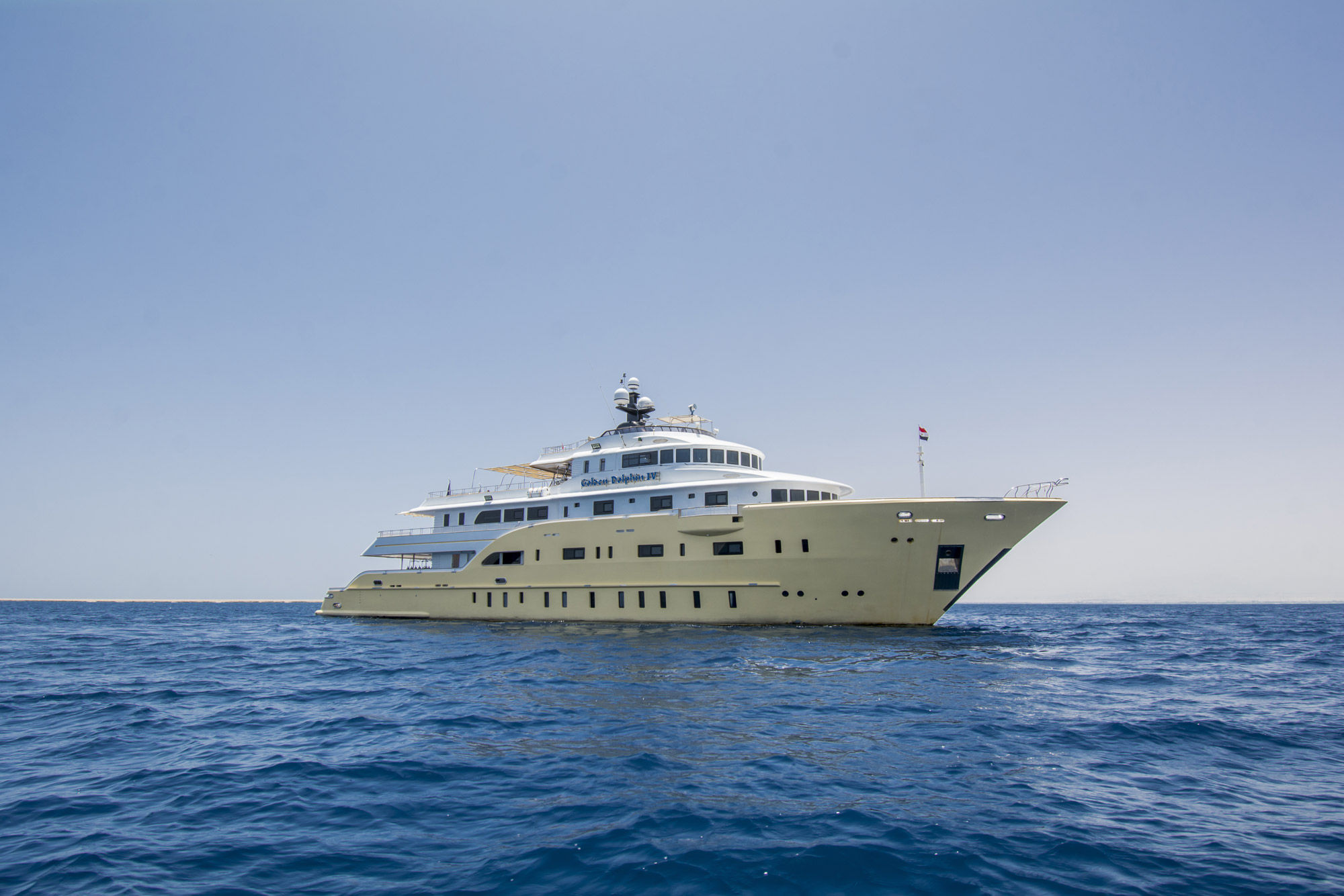日程安排
Daedalus Reef
Daedalus Reef 位于 Brother Islands 南部约180公里,是一个巨大的珊瑚礁。珊瑚礁的四周是陡峭的墙壁,南部有一个平台,从靠近珊瑚礁的28米到悬崖边缘的40米。如果天气允好,你可以尽量向北漂流,沿着珊瑚礁的一侧移动。这里经常可以看到礁鲨和双髻鲨(Hammerhead Shark)。水下海洋生物在这里比其他任何地方都更为丰富,有成群的白舸鱼(Surgeons)、胡椒鲷(Fusiliers)和鲹鱼(Carangids)。
Rocky Island
Rocky Island 的潜水点有许多被沙地环绕的水下岩石,20米深处有一个不错的可通过的通道。这里有美丽的鹿角珊瑚和硬珊瑚。你经常可以看到豹鲨和白鳍礁鲨(Whitetip Reef Shark)在沙地上休息。海龟和洄游性鱼类如巨型杰克鱼(Giant Trevally)也很常见。最大深度约39米,但大多数潜水点深度在15米左右。水流可能很强烈,这个潜水点更适合开放水域的高级潜水员。
Zabargad
Zabargad 岛自法老时期以来就因提取橄榄石(一种绿色的类似翡翠的石头)的古代矿山而闻名。在 Zabargad,你将在以多种美丽通道闻名的南墙潜水。
St Johns
位于埃及一侧最南边,离苏丹边界只有10英里的浩大珊瑚礁系统,有着令人赞叹的潜水点。它的珊瑚礁从隐藏于深蓝海水中的巨大水下高地上升起。
Sataya (Dolphine reef)
在 Marsa Alam 以南,Wadi Gimal 区域有一片巨大的珊瑚礁 Shaab Sharm。北侧和西北侧有色彩丰富的悬崖,东向17米到22米之间有 gorgonian 墙。东侧的平台从18米到32米深度,是众多海洋生物的家园。常见有医生鱼、不同种类的礁鱼、拿破仑鱼,以及各种小型生物 – 经常可以看到海龟在进食和休息。海豚、鲨鱼和魔鬼鱼在蓝色海域中巡逻。Wadi Gimal 的 Shilineat 是一个水族馆。沿着西侧美丽的硬珊瑚花园以及珊瑚礁旁边沙地上的大量珊瑚块,可以搜寻伪装高手和小型生物。最大深度为16米,白沙与阳光交相辉映,充满了小鱼种和多样种类。经常有海龟或海豚出没。
Elba Reef
Elba Reef 位于埃及与苏丹边境的 Halaib 三角区,北侧和南侧均有非常漂亮的平台,它是一个三角形珊瑚礁。北部的高原很长,始于约20米深,结束于约45米深。在高原边缘,可以找到许多巨大的珊瑚扇。南部高原边緣深海懸崖處有一艘主要吸引力的1900年代早期沉没的大型沉船“SS Isola di Levanzo”。她是一艘很少被访问的美丽沉船,周围的海底散布着破碎的雪利酒瓶。船的螺旋桨位于18米处,并且整个上层或船尾部分可以穿透。稍微靠近海岸,珊瑚礁相对较浅,但生长良好,珊瑚种类丰富。鱼类生物丰富,从礁石鱼类到鲨鱼都可以在此看到。
Brother Islands
Brother Islands 是世界上最好的潜水地点之一。岛屿 – 大 Brother 和小 Brother – 是两个小的露出海面在大海中间的海角,距埃及海岸线约60公里。小 Brother 的生命密度非常高,区域面积却非常小。墙壁上满是海绵、海葵以及各种硬软珊瑚,颜色和形状变化多样。当然,这里也有大量的鱼类。看到鲨鱼并不少见:双髻鲨、铠鲨、灰礁鲨、银鳍鲨和白鳍礁鲨。位于小 Brother 北部约一公里处是大 Brother。岛的中部坐落着一个灯塔。当不太有风时,你可以前往岛的北侧潜水至 Wreck NUMIDIA,它沉没于1901年,现在完全被硬和软珊瑚以及 gorgonias 覆盖。岛的西北侧可以找到另一艘沉船:AIDA。这个长82米的轮船沉没于1957年。沉船的残骸遍布珊瑚礁,只有船体后部可以在34米到60米间看到。它生长良好,值得一游。由于强流和可能的高浪,Brother Islands 的潜水并不容易。此狩猎游仅适合有经验的潜水员。
Safaga
Safaga 最著名的潜水点是 Abu Kufan,以春末的双髻鲨和冬季魔鬼鱼而闻名。这个长300米、狭窄的珊瑚礁在北部和南部尖端都有平台。Panorama Reef 是 Safaga 最大的珊瑚礁之一,拥有众多的石穴和突出部分,频繁的养育活力的洋流使这里的gorgonians和软珊瑚繁盛。由于礁屏的体积庞大,这里有至少三种不同的潜水项目:南部平台和东、西悬崖的深潜。Tobia Arbaa 被命名为“七柱”,是因为从砂底升起的小石柱。这是 Safaga 最好的潜水点之一,尽管底部较浅,影响能见度。软珊瑚覆盖着所有七个 EGRS,玻璃鱼、gorgonians、大型河豚鱼、章鱼、蓝斑刺尾鲷、海鳗、狮子鱼、军曹鱼、裸鳃类,以及更多。
Itinerary Sample
- 登船时间:到达当日下午6:00开始登船。
- 出发时间:船只将于翌日前中午离开码头。
- 潜水计划:每天计划3–4次潜水,具体依路线而定。潜水巡航的执行需遵从天气、海面条件、当地法规及潜水者技能水平。因此,无法保证特定珊瑚礁的访问。
- 最后一天:返回日前安排最多2次潜水,之后返航至码头。
- 餐食:巡航期间提供全食宿,但到达当日的晚餐和离开日的早餐除外。
- 退房时间:离开日,客人必须在上午10:00前下船。
- 住宿:出于组织或技术原因,最后一晚客人可能被安排入住半食宿酒店。
- 交通:提供到机场的接送服务。
- 注意:行程可能会有所变动。
最后一次潜水将安排在行程的倒数第二天。建议潜水员在最后一次潜水后等待24小时再飞行。
样本行程和地图仅为参考目的。实际路线和访问地点可能会根据当地法规、客人经验、天气和后勤障碍而更改,并由船长决定。
 微信扫码添加人工客服
微信扫码添加人工客服
